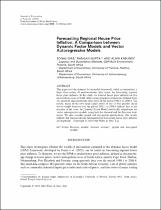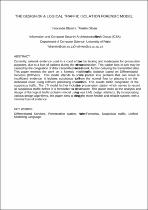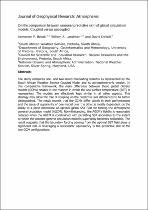 ResearchSpace
ResearchSpace
Modelling of channel transmission loss processes in semi-arid catchments of southern Africa using the Pitman Model
JavaScript is disabled for your browser. Some features of this site may not work without it.
- ResearchSpace
- →
- Research Publications/Outputs
- →
- Journal Articles
- →
- View Item
| dc.contributor.author |
Mvandaba, Vuyelwa

|
|
| dc.contributor.author |
Hughes, D

|
|
| dc.contributor.author |
Kapangaziwiri, Evison

|
|
| dc.contributor.author |
Mwenge Kahinda, Jean-Marc

|
|
| dc.contributor.author |
Oosthuizen, Nadia

|
|
| dc.date.accessioned | 2018-06-22T11:45:45Z | |
| dc.date.available | 2018-06-22T11:45:45Z | |
| dc.date.issued | 2018-05 | |
| dc.identifier.citation | Mvandaba, V. et al. 2018. Modelling of channel transmission loss processes in semi-arid catchments of southern Africa using the Pitman Model. Proceedings of the International Association of Hydrological Sciences, vol. 378: 17-22 | en_US |
| dc.identifier.issn | 2199-8981 | |
| dc.identifier.issn | 2199-899X | |
| dc.identifier.uri | https://www.proc-iahs.net/378/17/2018/ | |
| dc.identifier.uri | https://doi.org/10.5194/piahs-378-17-2018 | |
| dc.identifier.uri | http://hdl.handle.net/10204/10281 | |
| dc.description | © Author(s) 2018. This work is distributed under the Creative Commons Attribution 4.0 License. Article published in Proceedings of the International Association of Hydrological Sciences, vol. 378: 17-22 | en_US |
| dc.description.abstract | Water availability is one of the major societal issues facing the world. The ability to understand and quantify the impact of key hydrological processes, on the availability of water resources, is therefore integral to ensuring equitable and sustainable resource management. Channel transmission losses are an “under-researched” hydrological process that affects resource availability in many semi-arid regions such as the Limpopo River Basin in southern Africa, where the loss processes amount to approximately 30% of the water balance. To improve the understanding of these loss processes and test the capability of modelling routines, three approaches using the Pitman model are applied to selected alluvial aquifer environments. The three approaches are an explicit transmission loss function, the use of a wetland function to represent channel-floodplain storage exchanges and the use of a “dummy” reservoir to represent floodplain storage and evapotranspiration losses. Results indicate that all three approaches are able to simulate channel transmission losses with differing impacts on the regional flows. A determination of which method best represents the channel transmission losses process requires further testing in a study area that has reliable observed historical records. | en_US |
| dc.language.iso | en | en_US |
| dc.publisher | Copernicus Publications | en_US |
| dc.relation.ispartofseries | Worklist;20739 | |
| dc.subject | Hydrological modelling | en_US |
| dc.subject | Limpopo River Basin | en_US |
| dc.subject | Modelling uncertainty | en_US |
| dc.subject | Sensitivity analysis | en_US |
| dc.subject | Water Resources | en_US |
| dc.subject | Pitman model | en_US |
| dc.subject | transmission losses | en_US |
| dc.title | Modelling of channel transmission loss processes in semi-arid catchments of southern Africa using the Pitman Model | en_US |
| dc.type | Article | en_US |
| dc.identifier.apacitation | Mvandaba, V., Hughes, D., Kapangaziwiri, E., Mwenge Kahinda, J., & Oosthuizen, N. (2018). Modelling of channel transmission loss processes in semi-arid catchments of southern Africa using the Pitman Model. http://hdl.handle.net/10204/10281 | en_ZA |
| dc.identifier.chicagocitation | Mvandaba, Vuyelwa, D Hughes, Evison Kapangaziwiri, Jean-Marc Mwenge Kahinda, and Nadia Oosthuizen "Modelling of channel transmission loss processes in semi-arid catchments of southern Africa using the Pitman Model." (2018) http://hdl.handle.net/10204/10281 | en_ZA |
| dc.identifier.vancouvercitation | Mvandaba V, Hughes D, Kapangaziwiri E, Mwenge Kahinda J, Oosthuizen N. Modelling of channel transmission loss processes in semi-arid catchments of southern Africa using the Pitman Model. 2018; http://hdl.handle.net/10204/10281. | en_ZA |
| dc.identifier.ris | TY - Article AU - Mvandaba, Vuyelwa AU - Hughes, D AU - Kapangaziwiri, Evison AU - Mwenge Kahinda, Jean-Marc AU - Oosthuizen, Nadia AB - Water availability is one of the major societal issues facing the world. The ability to understand and quantify the impact of key hydrological processes, on the availability of water resources, is therefore integral to ensuring equitable and sustainable resource management. Channel transmission losses are an “under-researched” hydrological process that affects resource availability in many semi-arid regions such as the Limpopo River Basin in southern Africa, where the loss processes amount to approximately 30% of the water balance. To improve the understanding of these loss processes and test the capability of modelling routines, three approaches using the Pitman model are applied to selected alluvial aquifer environments. The three approaches are an explicit transmission loss function, the use of a wetland function to represent channel-floodplain storage exchanges and the use of a “dummy” reservoir to represent floodplain storage and evapotranspiration losses. Results indicate that all three approaches are able to simulate channel transmission losses with differing impacts on the regional flows. A determination of which method best represents the channel transmission losses process requires further testing in a study area that has reliable observed historical records. DA - 2018-05 DB - ResearchSpace DP - CSIR KW - Hydrological modelling KW - Limpopo River Basin KW - Modelling uncertainty KW - Sensitivity analysis KW - Water Resources KW - Pitman model KW - transmission losses LK - https://researchspace.csir.co.za PY - 2018 SM - 2199-8981 SM - 2199-899X T1 - Modelling of channel transmission loss processes in semi-arid catchments of southern Africa using the Pitman Model TI - Modelling of channel transmission loss processes in semi-arid catchments of southern Africa using the Pitman Model UR - http://hdl.handle.net/10204/10281 ER - | en_ZA |








